tire type Lancia Flavia 2012 Owner handbook (in English)
[x] Cancel search | Manufacturer: LANCIA, Model Year: 2012, Model line: Flavia, Model: Lancia Flavia 2012Pages: 233, PDF Size: 2.61 MB
Page 33 of 233

SEAT BELTS IN
PASSENGER SEATING
POSITIONS
The seat belts in the rear passenger
seating positions are equipped with
Automatic Locking Retractors (ALR)
which are used to secure a child re-
straint system. For additional infor-
mation, refer to “Installing Child Re-
straints Using The Vehicle Seat Belt”
under the “Child Restraints” section.
The chart below defines the type of
feature for each seating position.
Driver Center Passen-ger
First
Row N/A N/A N/A
Second Row ALR N/A ALR
N/A — Not Applicable
ALR — Automatic Locking Retrac- tor
If the passenger seating position is
equipped with an ALR and is being
used for normal usage: Only pull the belt webbing out far
enough to comfortably wrap around
the occupant's mid-section so as to
not activate the ALR. If the ALR is
activated, you will hear a ratcheting
sound as the belt retracts. Allow the
webbing to retract completely in this
case and then carefully pull out only
the amount of webbing necessary to
comfortably wrap around the occu-
pant's mid-section. Slide the latch
plate into the buckle until you hear a
"click."
AUTOMATIC LOCKING
RETRACTOR MODE (ALR)
In this mode, the shoulder belt is au-
tomatically pre-locked. The belt will
still retract to remove any slack in the
shoulder belt. The Automatic Locking
Mode is available on rear passenger-
seating positions with a combination
lap/shoulder belt. Use the Automatic
Locking Mode anytime a child safety
seat is installed in a seating position
that has a belt with this feature. Chil-
dren 12 years old and under should
always be properly restrained in the
rear seat.How To Engage The Automatic
Locking Mode
1. Buckle the combination lap and
shoulder belt.
2. Grasp the shoulder portion and
pull downward until the entire belt is
extracted.
3. Allow the belt to retract. As the
belt retracts, you will hear a clicking
sound. This indicates the safety belt is
now in the Automatic Locking Mode.
How To Disengage The Automatic
Locking Mode
Unbuckle the combination lap/
shoulder belt and allow it to retract
completely to disengage the Auto-
matic Locking Mode and activate the
vehicle sensitive (emergency) locking
mode.
26
Page 50 of 233

WARNING!Improper installation of a child re-
straint to the ISOFIX anchorages can
lead to failure of an infant or child
restraint. The child could be badly
injured or killed. Follow the manu-
facturer's directions exactly when in-
stalling an infant or child restraint.Installing Child Restraints Using
The Vehicle Seat Belts
The seat belts in the rear passenger
seating positions are equipped with
an Automatic Locking Retractor
(ALR) to secure a Child Restraint
System (CRS). These types of seat
belts are designed to keep the lap por-
tion of the seat belt tight around the
child restraint so that it is not neces-
sary to use a locking clip. The ALR
will make a ratcheting noise if you
extract the entire belt from the retrac-
tor and then allow the belt to retract
into the retractor. For additional in-
formation on ALR, refer to “Auto-
matic Locking Mode”. The chart be-
low defines the seating positions with
an Automatic Locking Retractor
(ALR) or a cinching latch plate.
Driver Center Passen-ger
First
Row N/A N/A N/A
Second Row ALR N/A ALR
N/A — Not Applicable
ALR — Automatic Locking Retrac- tor
Installing a Child Restraint with an
ALR:
1. To install a child restraint with
ALR, first, pull enough of the seat belt
webbing from the retractor to route it
through the belt path of the child re-
straint. Slide the latch plate into the
buckle until you hear a “click.” Next,
extract all the seat belt webbing out of
the retractor and then allow the belt to
retract into the retractor. As the belt
retracts, you will hear a ratcheting
sound. This indicates the safety belt is
now in the Automatic Locking mode.
2.
Finally, pull on any excess webbing
to tighten the lap portion around the
child restraint. Any seat belt system will
loosen with time, so check the belt oc-
casionally, and pull it tight if necessary.
In the rear seat, you may have trouble tightening the lap/shoulder
belt on the child restraint because
the buckle or latch plate is too close
to the belt path opening on the re-
straint. Disconnect the latch plate
from the buckle and twist the short
buckle-end belt several times to
shorten it. Insert the latch plate into
the buckle with the release button
facing out.
If the belt still can’t be tightened, or if pulling and pushing on the re-
straint loosens the belt, disconnect
the latch plate from the buckle,
turn the buckle around, and insert
the latch plate into the buckle
again. If you still can’t make the
child restraint secure, try a differ-
ent seating position.
To attach a child restraint tether
strap:
1. If lowered, raise the convertible
top.
NOTE:
The convertible top must be in the
UP position to access the tether
anchor.
43
Page 120 of 233
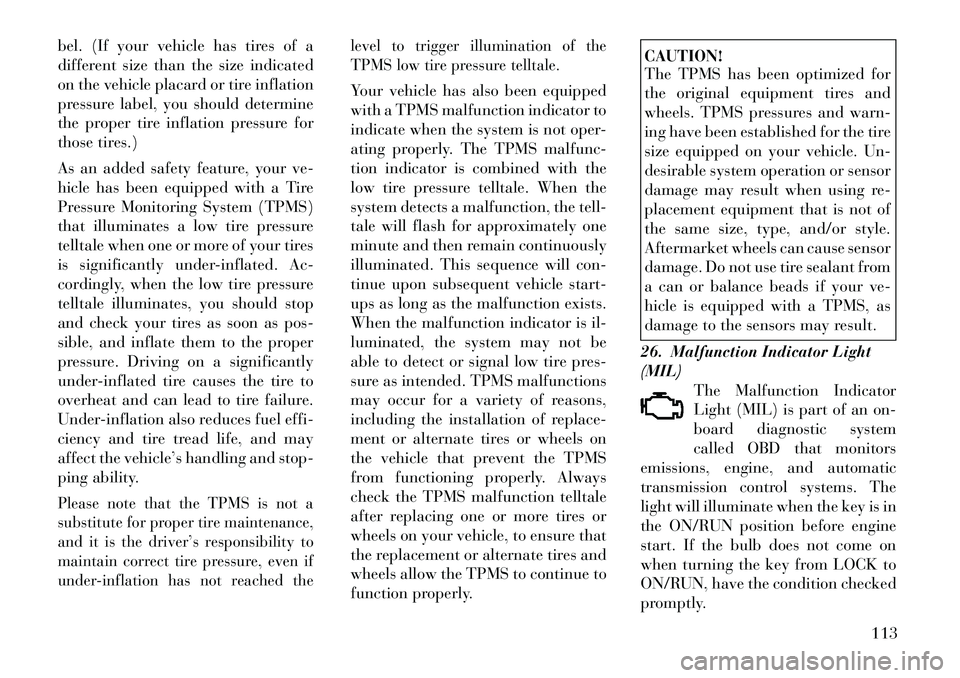
bel. (If your vehicle has tires of a
different size than the size indicated
on the vehicle placard or tire inflation
pressure label, you should determine
the proper tire inflation pressure for
those tires.)
As an added safety feature, your ve-
hicle has been equipped with a Tire
Pressure Monitoring System (TPMS)
that illuminates a low tire pressure
telltale when one or more of your tires
is significantly under-inflated. Ac-
cordingly, when the low tire pressure
telltale illuminates, you should stop
and check your tires as soon as pos-
sible, and inflate them to the proper
pressure. Driving on a significantly
under-inflated tire causes the tire to
overheat and can lead to tire failure.
Under-inflation also reduces fuel effi-
ciency and tire tread life, and may
affect the vehicle’s handling and stop-
ping ability.Please note that the TPMS is not a
substitute for proper tire maintenance,
and it is the driver’s responsibility to
maintain correct tire pressure, even if
under-inflation has not reached thelevel to trigger illumination of the
TPMS low tire pressure telltale.
Your vehicle has also been equipped
with a TPMS malfunction indicator to
indicate when the system is not oper-
ating properly. The TPMS malfunc-
tion indicator is combined with the
low tire pressure telltale. When the
system detects a malfunction, the tell-
tale will flash for approximately one
minute and then remain continuously
illuminated. This sequence will con-
tinue upon subsequent vehicle start-
ups as long as the malfunction exists.
When the malfunction indicator is il-
luminated, the system may not be
able to detect or signal low tire pres-
sure as intended. TPMS malfunctions
may occur for a variety of reasons,
including the installation of replace-
ment or alternate tires or wheels on
the vehicle that prevent the TPMS
from functioning properly. Always
check the TPMS malfunction telltale
after replacing one or more tires or
wheels on your vehicle, to ensure that
the replacement or alternate tires and
wheels allow the TPMS to continue to
function properly.
CAUTION!
The TPMS has been optimized for
the original equipment tires and
wheels. TPMS pressures and warn-
ing have been established for the tire
size equipped on your vehicle. Un-
desirable system operation or sensor
damage may result when using re-
placement equipment that is not of
the same size, type, and/or style.
Aftermarket wheels can cause sensor
damage. Do not use tire sealant from
a can or balance beads if your ve-
hicle is equipped with a TPMS, as
damage to the sensors may result.
26. Malfunction Indicator Light
(MIL) The Malfunction Indicator
Light (MIL) is part of an on-
board diagnostic system
called OBD that monitors
emissions, engine, and automatic
transmission control systems. The
light will illuminate when the key is in
the ON/RUN position before engine
start. If the bulb does not come on
when turning the key from LOCK to
ON/RUN, have the condition checked
promptly.
113
Page 154 of 233
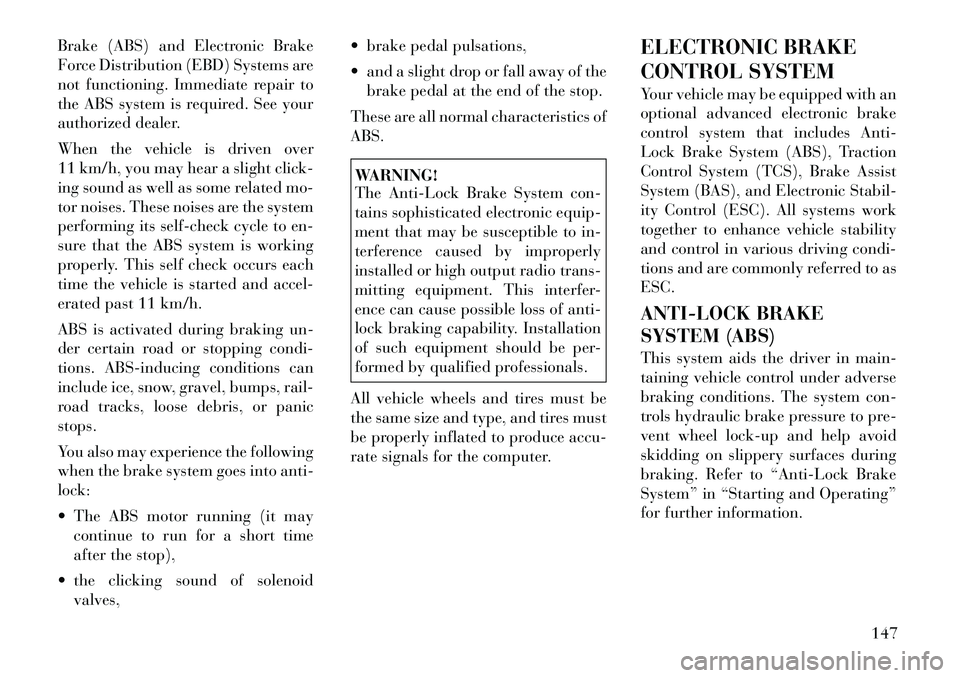
Brake (ABS) and Electronic Brake
Force Distribution (EBD) Systems are
not functioning. Immediate repair to
the ABS system is required. See your
authorized dealer.
When the vehicle is driven over
11 km/h, you may hear a slight click-
ing sound as well as some related mo-
tor noises. These noises are the system
performing its self-check cycle to en-
sure that the ABS system is working
properly. This self check occurs each
time the vehicle is started and accel-
erated past 11 km/h.
ABS is activated during braking un-
der certain road or stopping condi-
tions. ABS-inducing conditions can
include ice, snow, gravel, bumps, rail-
road tracks, loose debris, or panic
stops.
You also may experience the following
when the brake system goes into anti-
lock:
The ABS motor running (it maycontinue to run for a short time
after the stop),
the clicking sound of solenoid valves, brake pedal pulsations,
and a slight drop or fall away of the
brake pedal at the end of the stop.
These are all normal characteristics of
ABS.
WARNING!
The Anti-Lock Brake System con-
tains sophisticated electronic equip-
ment that may be susceptible to in-
terference caused by improperly
installed or high output radio trans-
mitting equipment. This interfer-
ence can cause possible loss of anti-
lock braking capability. Installation
of such equipment should be per-
formed by qualified professionals.
All vehicle wheels and tires must be
the same size and type, and tires must
be properly inflated to produce accu-
rate signals for the computer. ELECTRONIC BRAKE
CONTROL SYSTEM
Your vehicle may be equipped with an
optional advanced electronic brake
control system that includes Anti-
Lock Brake System (ABS), Traction
Control System (TCS), Brake Assist
System (BAS), and Electronic Stabil-
ity Control (ESC). All systems work
together to enhance vehicle stability
and control in various driving condi-
tions and are commonly referred to as
ESC.
ANTI-LOCK BRAKE
SYSTEM (ABS)
This system aids the driver in main-
taining vehicle control under adverse
braking conditions. The system con-
trols hydraulic brake pressure to pre-
vent wheel lock-up and help avoid
skidding on slippery surfaces during
braking. Refer to “Anti-Lock Brake
System” in “Starting and Operating”
for further information.
147
Page 159 of 233
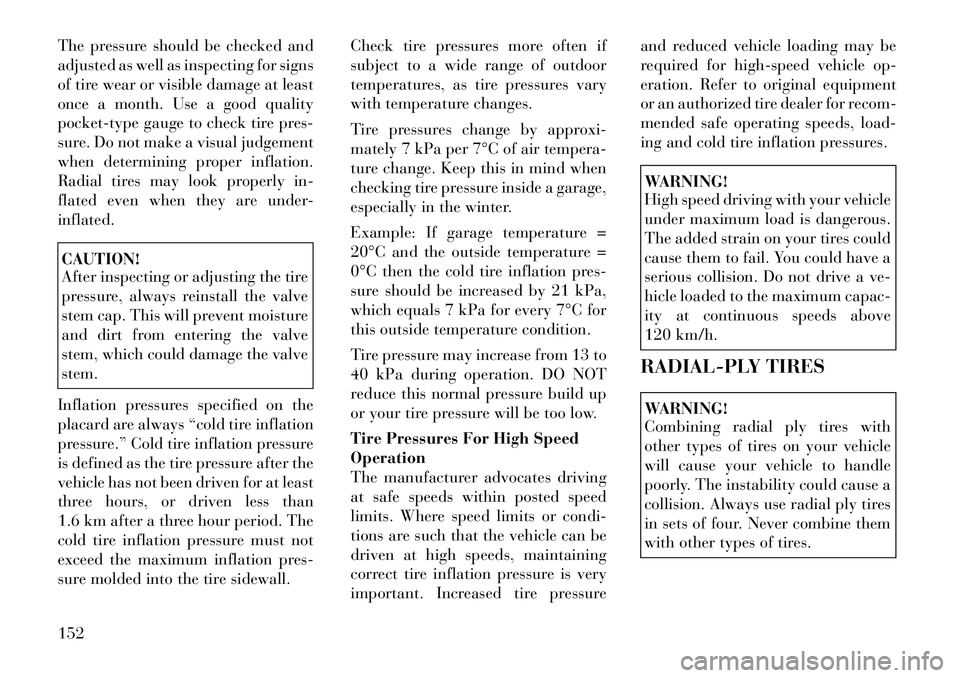
The pressure should be checked and
adjusted as well as inspecting for signs
of tire wear or visible damage at least
once a month. Use a good quality
pocket-type gauge to check tire pres-
sure. Do not make a visual judgement
when determining proper inflation.
Radial tires may look properly in-
flated even when they are under-
inflated.CAUTION!
After inspecting or adjusting the tire
pressure, always reinstall the valve
stem cap. This will prevent moisture
and dirt from entering the valve
stem, which could damage the valve
stem.
Inflation pressures specified on the
placard are always “cold tire inflation
pressure.” Cold tire inflation pressure
is defined as the tire pressure after the
vehicle has not been driven for at least
three hours, or driven less than
1.6 km after a three hour period. The
cold tire inflation pressure must not
exceed the maximum inflation pres-
sure molded into the tire sidewall. Check tire pressures more often if
subject to a wide range of outdoor
temperatures, as tire pressures vary
with temperature changes.
Tire pressures change by approxi-
mately 7 kPa per 7°C of air tempera-
ture change. Keep this in mind when
checking tire pressure inside a garage,
especially in the winter.
Example: If garage temperature =
20°C and the outside temperature =
0°C then the cold tire inflation pres-
sure should be increased by 21 kPa,
which equals 7 kPa for every 7°C for
this outside temperature condition.
Tire pressure may increase from 13 to
40 kPa during operation. DO NOT
reduce this normal pressure build up
or your tire pressure will be too low.
Tire Pressures For High Speed
Operation
The manufacturer advocates driving
at safe speeds within posted speed
limits. Where speed limits or condi-
tions are such that the vehicle can be
driven at high speeds, maintaining
correct tire inflation pressure is very
important. Increased tire pressureand reduced vehicle loading may be
required for high-speed vehicle op-
eration. Refer to original equipment
or an authorized tire dealer for recom-
mended safe operating speeds, load-
ing and cold tire inflation pressures.
WARNING!
High speed driving with your vehicle
under maximum load is dangerous.
The added strain on your tires could
cause them to fail. You could have a
serious collision. Do not drive a ve-
hicle loaded to the maximum capac-
ity at continuous speeds above
120 km/h.
RADIAL-PLY TIRESWARNING!
Combining radial ply tires with
other types of tires on your vehicle
will cause your vehicle to handle
poorly. The instability could cause a
collision. Always use radial ply tires
in sets of four. Never combine them
with other types of tires.
152
Page 162 of 233
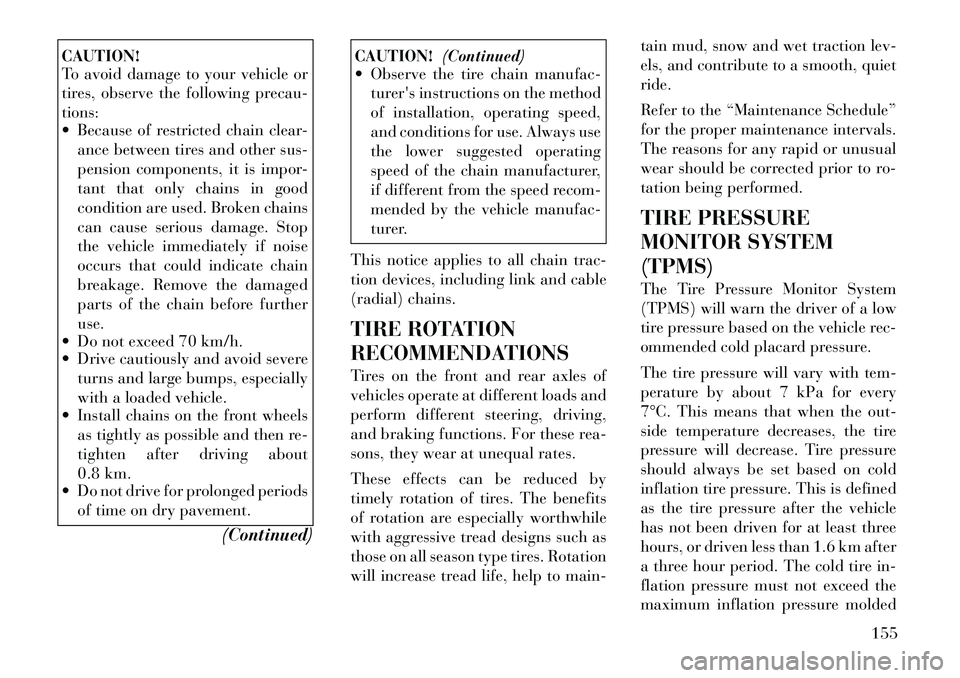
CAUTION!
To avoid damage to your vehicle or
tires, observe the following precau-
tions:
Because of restricted chain clear-ance between tires and other sus-
pension components, it is impor-
tant that only chains in good
condition are used. Broken chains
can cause serious damage. Stop
the vehicle immediately if noise
occurs that could indicate chain
breakage. Remove the damaged
parts of the chain before further
use.
Do not exceed 70 km/h.
Drive cautiously and avoid severe
turns and large bumps, especially
with a loaded vehicle.
Install chains on the front wheels
as tightly as possible and then re-
tighten after driving about
0.8 km.
Do not drive for prolonged periods
of time on dry pavement.
(Continued)
CAUTION!(Continued)
Observe the tire chain manufac-
tur er's instructions on the method
of installation, operating speed,
and conditions for use. Always use
the lower suggested operating
speed of the chain manufacturer,
if different from the speed r ecom-
mended by the vehicle manufac-
turer.
This notice applies to all chain trac-
tion devices, including link and cable
(radial) chains.
TIRE ROTATION
RECOMMENDATIONS
Tires on the front and rear axles of
vehicles operate at different loads and
perform different steering, driving,
and braking functions. For these rea-
sons, they wear at unequal rates.
These effects can be reduced by
timely rotation of tires. The benefits
of rotation are especially worthwhile
with aggressive tread designs such as
those on all season type tires. Rotation
will increase tread life, help to main- tain mud, snow and wet traction lev-
els, and contribute to a smooth, quiet
ride.
Refer to the “Maintenance Schedule”
for the proper maintenance intervals.
The reasons for any rapid or unusual
wear should be corrected prior to ro-
tation being performed.
TIRE PRESSURE
MONITOR SYSTEM
(TPMS)
The Tire Pressure Monitor System
(TPMS) will warn the driver of a low
tire pressure based on the vehicle rec-
ommended cold placard pressure.
The tire pressure will vary with tem-
perature by about 7 kPa for every
7°C. This means that when the out-
side temperature decreases, the tire
pressure will decrease. Tire pressure
should always be set based on cold
inflation tire pressure. This is defined
as the tire pressure after the vehicle
has not been driven for at least three
hours, or driven less than 1.6 km after
a three hour period. The cold tire in-
flation pressure must not exceed the
maximum inflation pressure molded
155
Page 163 of 233
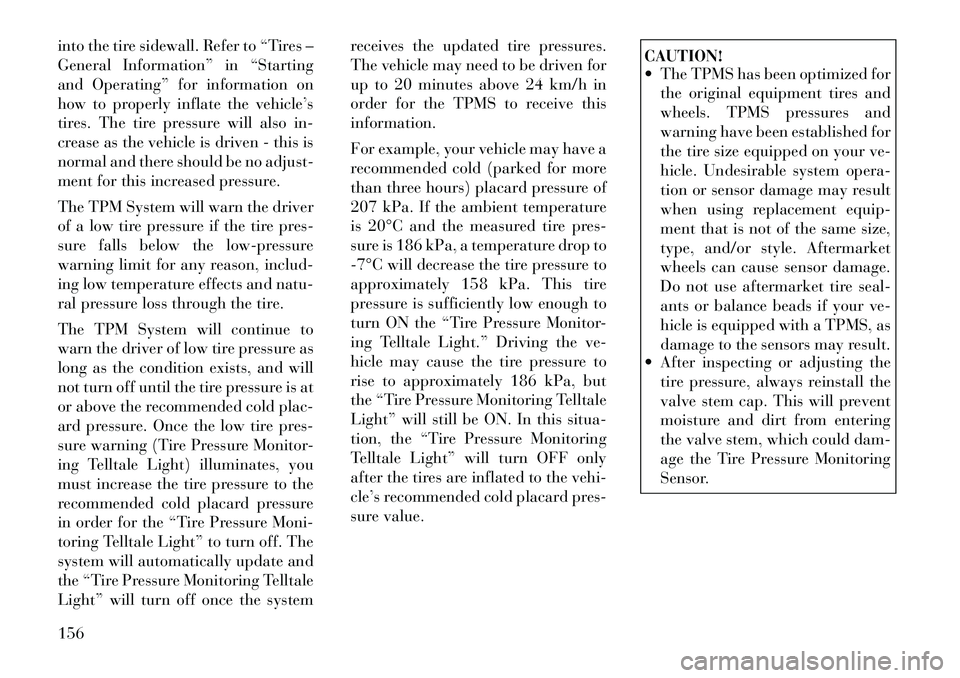
into the tire sidewall. Refer to “Tires –
General Information” in “Starting
and Operating” for information on
how to properly inflate the vehicle’s
tires. The tire pressure will also in-
crease as the vehicle is driven - this is
normal and there should be no adjust-
ment for this increased pressure.
The TPM System will warn the driver
of a low tire pressure if the tire pres-
sure falls below the low-pressure
warning limit for any reason, includ-
ing low temperature effects and natu-
ral pressure loss through the tire.
The TPM System will continue to
warn the driver of low tire pressure as
long as the condition exists, and will
not turn off until the tire pressure is at
or above the recommended cold plac-
ard pressure. Once the low tire pres-
sure warning (Tire Pressure Monitor-
ing Telltale Light) illuminates, you
must increase the tire pressure to the
recommended cold placard pressure
in order for the “Tire Pressure Moni-
toring Telltale Light” to turn off. The
system will automatically update and
the “Tire Pressure Monitoring Telltale
Light” will turn off once the systemreceives the updated tire pressures.
The vehicle may need to be driven for
up to 20 minutes above 24 km/h in
order for the TPMS to receive this
information.
For example, your vehicle may have a
recommended cold (parked for more
than three hours) placard pressure of
207 kPa. If the ambient temperature
is 20°C and the measured tire pres-
sure is 186 kPa, a temperature drop to
7°C will decrease the tire pressure to
approximately 158 kPa. This tire
pressure is sufficiently low enough to
turn ON the “Tire Pressure Monitor-
ing Telltale Light.” Driving the ve-
hicle may cause the tire pressure to
rise to approximately 186 kPa, but
the “Tire Pressure Monitoring Telltale
Light” will still be ON. In this situa-
tion, the “Tire Pressure Monitoring
Telltale Light” will turn OFF only
after the tires are inflated to the vehi-
cle’s recommended cold placard pres-
sure value.
CAUTION!
The TPMS has been optimized for
the original equipment tires and
wheels. TPMS pressures and
warning have been established for
the tire size equipped on your ve-
hicle. Undesirable system opera-
tion or sensor damage may result
when using replacement equip-
ment that is not of the same size,
type, and/or style. Aftermarket
wheels can cause sensor damage.
Do not use aftermarket tire seal-
ants or balance beads if your ve-
hicle is equipped with a TPMS, as
damage to the sensors may result.
After inspecting or adjusting the
tire pressure, always reinstall the
valve stem cap. This will prevent
moisture and dirt from entering
the valve stem, which could dam-
age the Tire Pressure Monitoring
Sensor.
156
Page 169 of 233
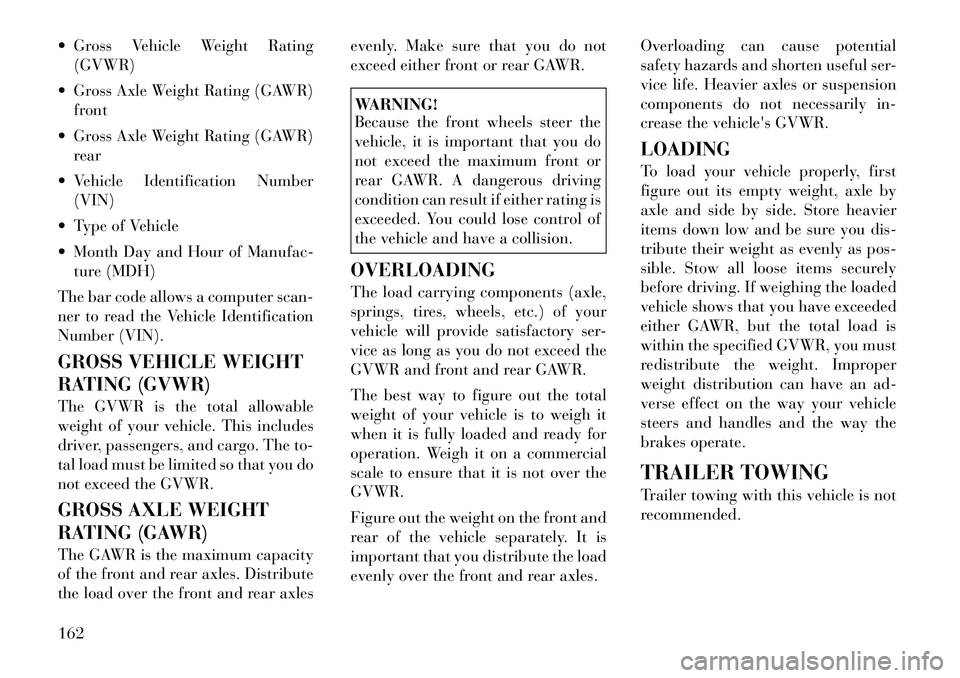
Gross Vehicle Weight Rating(GVWR)
Gross Axle Weight Rating (GAWR) front
Gross Axle Weight Rating (GAWR) rear
Vehicle Identification Number (VIN)
Type of Vehicle
Month Day and Hour of Manufac- ture (MDH)
The bar code allows a computer scan-
ner to read the Vehicle Identification
Number (VIN).
GROSS VEHICLE WEIGHT
RATING (GVWR)
The GVWR is the total allowable
weight of your vehicle. This includes
driver, passengers, and cargo. The to-
tal load must be limited so that you do
not exceed the GVWR.
GROSS AXLE WEIGHT
RATING (GAWR)
The GAWR is the maximum capacity
of the front and rear axles. Distribute
the load over the front and rear axles evenly. Make sure that you do not
exceed either front or rear GAWR.
WARNING!
Because the front wheels steer the
vehicle, it is important that you do
not exceed the maximum front or
rear GAWR. A dangerous driving
condition can result if either rating is
exceeded. You could lose control of
the vehicle and have a collision.
OVERLOADING
The load carrying components (axle,
springs, tires, wheels, etc.) of your
vehicle will provide satisfactory ser-
vice as long as you do not exceed the
GVWR and front and rear GAWR.
The best way to figure out the total
weight of your vehicle is to weigh it
when it is fully loaded and ready for
operation. Weigh it on a commercial
scale to ensure that it is not over the
GVWR.
Figure out the weight on the front and
rear of the vehicle separately. It is
important that you distribute the load
evenly over the front and rear axles. Overloading can cause potential
safety hazards and shorten useful ser-
vice life. Heavier axles or suspension
components do not necessarily in-
crease the
vehicle's GVWR.
LOADING
To load your vehicle properly, first
figure out its empty weight, axle by
axle and side by side. Store heavier
items down low and be sure you dis-
tribute their weight as evenly as pos-
sible. Stow all loose items securely
before driving. If weighing the loaded
vehicle shows that you have exceeded
either GAWR, but the total load is
within the specified GVWR, you must
redistribute the weight. Improper
weight distribution can have an ad-
verse effect on the way your vehicle
steers and handles and the way the
brakes operate.
TRAILER TOWING
Trailer towing with this vehicle is not
recommended.
162
Page 206 of 233

Immediate removal of any contami-
nant is recommended. Regular wash-
ing of the top will enhance its life and
appearance, and make successive
cleanings easier. Do not subject the
top to excessive heat. Frequently
vacuum the top and storage compart-
ment.
Washing
Hand washing is highly recom-
mended. Automatic car washing
equipment can damage the top mate-
rial. If you must use an automatic car
wash, soft cloth systems are preferred.CAUTION!
Avoid high-pressure car washes, as
they can damage the top material.
Also, increased water pressure may
force water past the weather strips.
General Cleaning
Careful vacuuming of the top before
washing is helpful in removing dust
and other foreign particles. Wash in
partial shade instead of direct sun.
Wet the entire vehicle before washing
the top. The top should be washed
with a soft, natural bristle scrub brush, and a mild soap solution such
as liquid dishwashing soap. Do not
use detergent.
CAUTION!
Never use an abrasive type cleaner
or bleaches. Cleaners should not
contain silicones, organic solvents,
petroleum distillates, or plasticizers.
Always wait until the top is thor-
oughly dry before lowering it into
the storage area.
Scrub in all directions, covering an
area of about two square feet at a
time. Avoid heavy scrubbing. Rinse
the entire vehicle with water to re-
move all soap and dirt from the top
fabric and to prevent streaking on
painted and chrome surfaces. Allow
the top to dry before lowering. Vacu-
uming the top with a wet/dry shop
vacuum will decrease the top's drying
time, ensure removal of all dirt, and
delete streaks in the material. Mul-
tiple cleanings may be necessary to
remove stubborn stains. If stains per-
sist, contact your local dealership for
further suggestions. Additional Cleaning Procedure
For additional cleaning assistance in
removing stubborn stains, apply ap-
propriate cleaners to the complete
stain, extending 50 mm beyond the
stain. With a soft bristle brush, scrub
in all directions over the stain. Avoid
heavy scrubbing. Rinse the area with
warm water. If the stain is still appar-
ent, repeat the cleaning procedure.
When the stain is no longer showing,
rinse the complete top with warm wa-
ter. Let the top dry before lowering it.
Protection
For appearance purposes, you may
wish to protect your cloth top periodi-
cally. A fabric protectant is suggested.
The top should be clean and dry be-
fore application of the protectant.
CAUTION!
Avoid getting the fabric protectant
on the surrounding weather strips,
moldings, paint, or glass. Damage to
these items might occur.
199
Page 223 of 233

About Your Brakes . . . . . . . . . 145
ABS
(Anti-Lock Brake System) . . . 146
Adding Engine Coolant
(Antifreeze) . . . . . . . . . . . . . . 191
Adding Washer Fluid . . . . . . . 188
Additives, Fuel . . . . . . . . . . . 160
Air Cleaner, Engine
(Engine Air Cleaner Filter) . . . 184
Air Conditioner
Maintenance . . . . . . . . . . . . . 186
Air Conditioning Filter . . . 128,186
Air Conditioning Refrigerant . . 186
Air Conditioning
System . . . . . . . . . . . . . . 124,186
Air Conditioning, Operating
Tips . . . . . . . . . . . . . . . . . . . 129
Air Pressure, Tires . . . . . . . . . 151
Airbag . . . . . . . . . . . . . . . . . . 30
Airbag Deployment . . . . . . . . . 34
Airbag Light . . . . 32,33,36,46,108
Airbag Maintenance . . . . . . . . . 35
Airbag, Side . . . . . . . . . . 31,32,33
Airbag, Window
(Side Curtain) . . . . . . . . . . . . . 32
Alarm (Security Alarm) . . . . . . 14
Alarm System
(Security Alarm) . . . . . . . . 14,112Alterations/Modifications,
Vehicle . . . . . . . . . . . . . . . . . . . 7
Anti-Lock Brake System
(ABS) . . . . . . . . . . . . . . . . . . 146
Anti-Lock Warning Light . . . . 146
Anti-Theft Security Alarm
(Theft Alarm) . . . . . . . . . . . . . 14
Antifreeze
(Engine Coolant) . . . . . . . 191,206
Disposal . . . . . . . . . . . . . . 192
Appearance Care . . . . . . . . . . 196
Ashtray . . . . . . . . . . . . . . . . . 100
Auto Down Power Windows . . . 19
Auto Unlock, Doors . . . . . . . . . 18
Automatic Door Locks . . . . . . . 18
Automatic Headlights . . . . . . . 91
Automatic Oil Change
Indicator . . . . . . . . . . . . 110,117
Automatic Temperature
Control (ATC) . . . . . . . . . . . . 124
Automatic Transaxle . . . . . 12,134 Adding Fluid . . . . . . . . . . . 207
Selection Of Lubricant . . . . 207
Automatic Transmission . . 135,194 Adding Fluid . . . . . . . . . . . 195
Fluid and Filter Changes . . . 195
Fluid Level Check . . . . . . . 195
Fluid Type . . . . . . . . . . . . . 195
Gear Ranges . . . . . . . . . . . 137 Special Additives . . . . . . . . 195
Autostick . . . . . . . . . . . . . . . 141
Battery . . . . . . . . . . . . . . . . . 185
Keyless Transmitter
Replacement (RKE) . . . . . . . 17
Location . . . . . . . . . . . . . . 185
Belts, Seat . . . . . . . . . . . . . 23,45
Body Mechanism
Lubrication . . . . . . . . . . . . . . 187
Brake Assist System . . . . . . . . 148
Brake Fluid . . . . . . . . . . . . . . 207
Brake System . . . . . . . . . . . . 193 Anti-Lock (ABS) . . . . . . . . 146
Fluid Check . . . . . . . . 194,207
Master Cylinder . . . . . . . . . 194
Parking . . . . . . . . . . . . . . . 145
Warning Light . . . . . . . . . . 108
Brake, Parking . . . . . . . . . . . 145
Brake/Transmission
Interlock . . . . . . . . . . . . . . . . 136
Brakes . . . . . . . . . . . . . . . . . 193
Break-In Recommendations,
New Vehicle . . . . . . . . . . . . . . 44
Bulb Replacement . . . . . . . . . 203
Bulbs, Light . . . . . . . . . . . 47,203
Calibration, Compass . . . . . . . 118
216